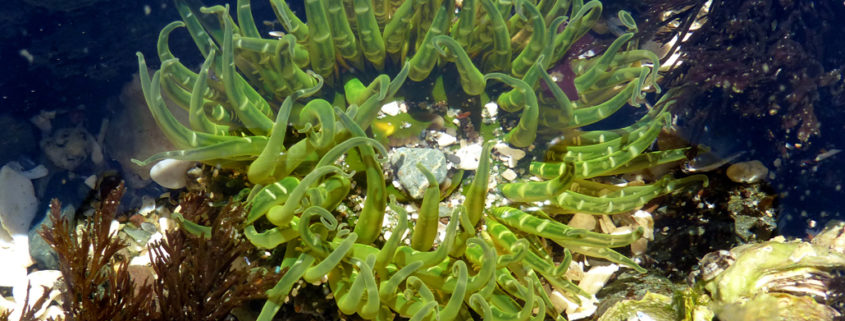Burrowing Green Anemone
Scientific name: Anthopleura artemisia (Cribrina artemisia)
Author: Elliot Scott-Bigsby
Identifying features: The Burrowing Green Anemone’s crown is up to 10 cm (4.0 in) in diameter, with a column of up to 25 cm long (9.8 in). It is often found partially buried in sand of shells, with the exposed part a green colour, with bands of white. The column is pink or white, and its base will attach itself to rock, or something similarly sturdy, underneath the sediment. It may be found with all tentacles displayed and visible, withdrawn, appearing as an unclear shape, or possibly as a puckered hole in the sand.
Geographical range: Found from Alaska to southern California, and are especially common around Juneau, Alaska.
Habitat: Usually in protected bays, preferably with rocks and cobble covered with a layered of sand. It’ll also occasionally be found around open coasts. It’s depth will be between low intertidal and subtidal zones, up to about 30 m in depth.
Food (Prey): They’re carnivorous and stationary in shallow areas, making their primary prey small crustaceans, but they will attempt to capture and eat whatever creatures touch their tentacles.
Predators: It is prey to nudibranchs and small fish.
References:
Cowles, D. (2004) Anthopleura artemisia. Retrieved from https://inverts.wallawalla.edu/Cnidaria/Class-Anthozoa/Subclass_Zoantharia/Order_Actiniaria/Anthopleura_artemisia.html
Fretwell, K. and Starzomski, B. (2013) Buried green anemone, moonglow anemone, burrowing anemone, Anthopleura artemisia. Retrieved from https://www.centralcoastbiodiversity.org/buried-green-anemone-bull-anthopleura-artemisia.html
Piazzola, C.D. and Hiebert T.C. (2015) Anthopleura artemisia. Retrieved from https://scholarsbank.uoregon.edu/xmlui/bitstream/handle/1794/12638/A_artemisia_2015_final.pdf?sequence=3





Leave a Reply
Want to join the discussion?Feel free to contribute!